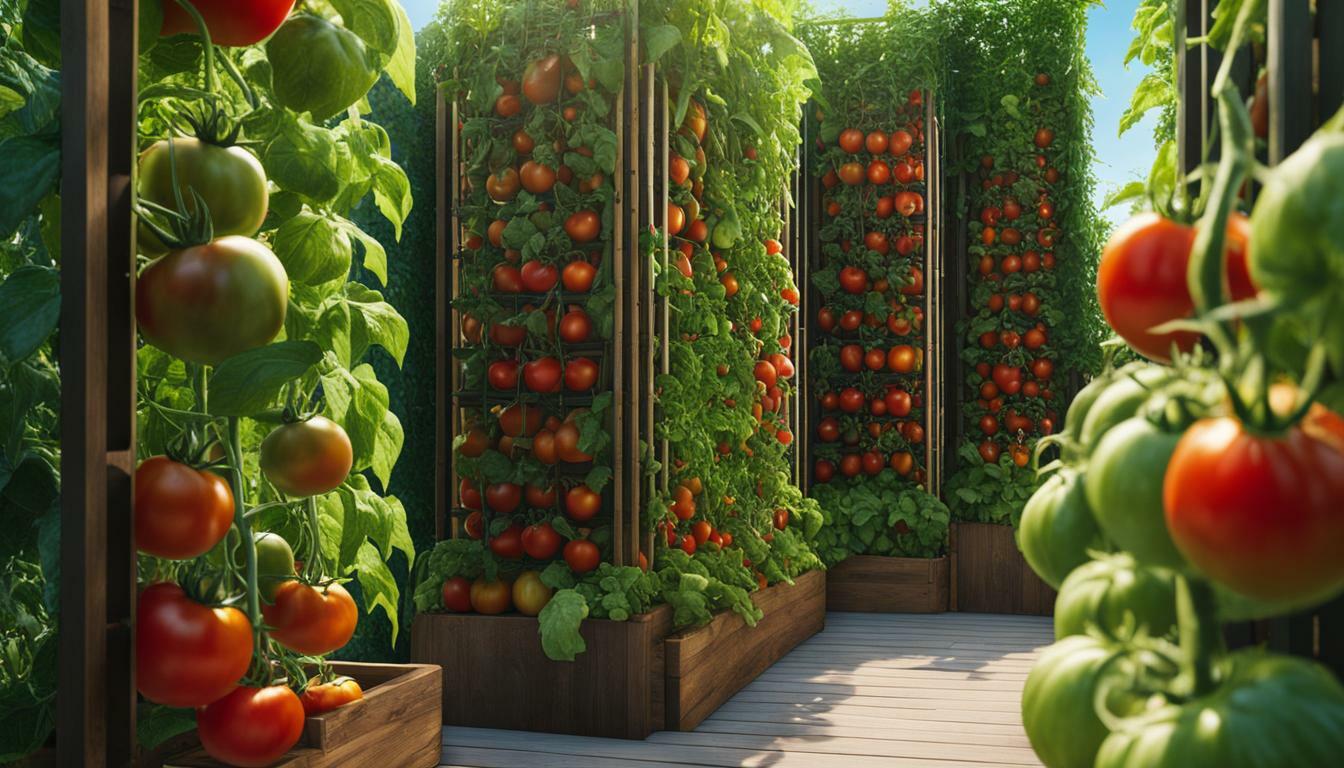Vertical tomato gardening is a popular technique for maximizing space and achieving a thriving tomato garden in your backyard. If you don’t have enough space for a traditional in-ground garden, vertical tomato gardens offer a solution. By training tomato plants to grow vertically using support systems like trellises, cages, and stakes, you can create a productive garden even in small spaces.
In this article, we will explore the concept of vertical tomato gardening, why it is beneficial, and how to successfully grow a vertical tomato garden in your backyard. From choosing the right location and tomato plants to understanding the importance of space efficiency and plant health, we will cover all the basics you need to know for a successful vertical tomato garden.
Key Takeaways:
- Vertical tomato gardening is an effective way to maximize space in your backyard.
- Vertical gardens offer increased yield and better air circulation for tomato plants.
- They also provide improved sunlight exposure and make pest management and harvesting easier.
- Choosing the right location and tomato plants is crucial for the success of your vertical garden.
- Container gardening is a viable option for vertical tomato gardens in small spaces.
What is a Vertical Tomato Garden?
A vertical tomato garden involves training tomato plants to grow vertically using support systems such as trellises, cages, and stakes. Rather than allowing the plants to sprawl along the ground, a vertical garden encourages upward growth, maximizing space and improving plant health.
By utilizing vertical gardening techniques, gardeners can overcome the challenges of limited space and create a thriving tomato garden even in small urban areas. Vertical tomato gardens have become increasingly popular due to their space-efficient nature and the numerous benefits they offer.
Vertical gardens not only provide an innovative solution for small-space gardening but also offer an aesthetically pleasing addition to any backyard. With strategically placed trellises or cages, a vertical tomato garden can transform a plain wall or fence into a lush, green vertical oasis.
| Advantages of Vertical Tomato Gardens |
|---|
| Maximize space utilization |
| Promote better plant health and disease prevention |
| Enhance sunlight exposure and air circulation |
| Easier pest management and harvesting |
Vertical tomato gardens offer numerous advantages over traditional ground-based gardening methods. By growing tomatoes vertically, gardeners can make the most of their available space, whether it’s a small backyard, balcony, or even an indoor area.
These gardens provide improved plant health and disease prevention by keeping the plants off the ground, reducing the risk of pests and diseases. The vertical positioning allows for enhanced sunlight exposure and better air circulation, leading to stronger plants and higher yields.
Furthermore, vertical gardens make pest management easier and harvesting more convenient. With the vines and foliage spread out, pests are more visible and can be dealt with promptly. Harvesting becomes a breeze as the tomatoes are easily accessible and can be plucked off the plants without any difficulty.
Choosing the Right Location and Tomato Plants
When setting up a vertical tomato garden, selecting the right location and tomato plants is crucial for success. The chosen location should receive at least eight hours of full sunlight and provide easy access for watering.
For vertical gardens, it is recommended to opt for indeterminate tomato varieties, as they continue to grow and produce fruit throughout the entire season. These plants require a physical support system and are ideal for vertical gardening.
Containers can also be used for vertical tomato gardening, especially in small spaces or urban areas. It is important to choose containers with good drainage and size them according to the specific tomato variety being planted.
Vertical tomato gardens offer a creative and efficient way to grow tomatoes in limited space. By utilizing support systems like trellises or cages, gardeners can train their tomato plants to grow vertically and enjoy the benefits of increased space, improved plant health, and easier maintenance. With proper location selection and the right tomato plants, anyone can successfully create a thriving vertical tomato garden.
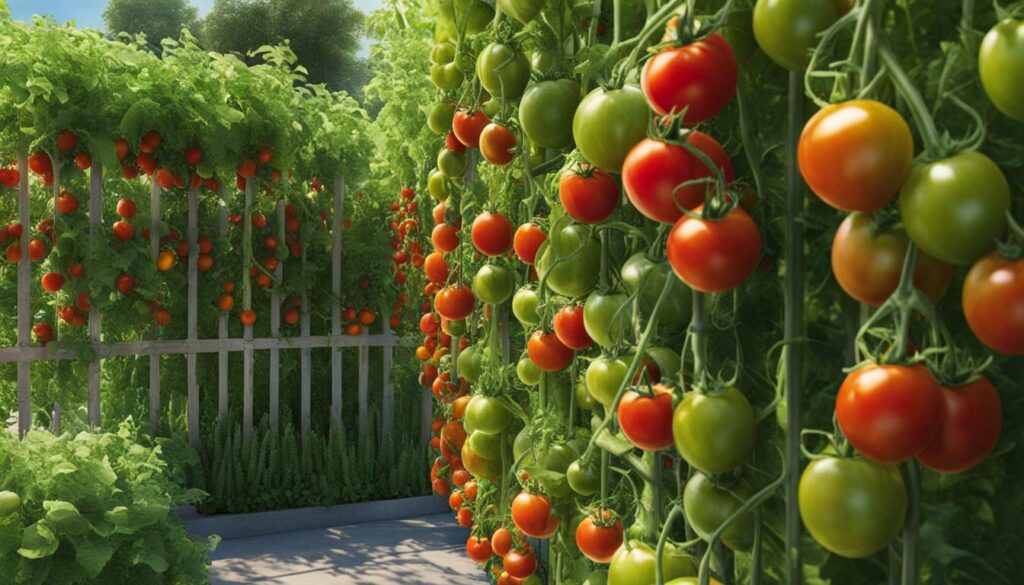
Overall, vertical tomato gardening provides an innovative solution for maximizing space and enjoying a bountiful harvest. With careful planning and attention to proper techniques, gardeners can master the basics of vertical tomato gardening and create a thriving garden in their own backyard.
Why Grow a Vertical Tomato Garden?
There are numerous reasons why you should consider growing a vertical tomato garden in your backyard. Vertical tomato gardens offer a solution for those who may not have enough space for a traditional in-ground garden. Whether you have a small yard or limited outdoor space, vertical gardens allow you to maximize your growing area by training tomato plants to grow vertically using a support system like a trellis, cage, or stakes.
One of the key advantages of vertical tomato gardens is their space efficiency. By growing tomatoes vertically, you can produce more fruit per horizontal square foot compared to traditional methods. This is especially beneficial for small space gardening, where maximizing yield is essential. Vertical gardens also keep the tomato plants off the ground, preventing them from sprawling and taking up unnecessary space.
In addition to space efficiency, vertical tomato gardens promote better plant health and disease prevention. When tomato plants are grown vertically, they are lifted off the soil, reducing the risk of pests and diseases. The plants have improved air circulation, which helps to dry off excess moisture and prevent the growth of mold. Vertical gardens also provide better sunlight exposure to the foliage and fruits, leading to healthier and more productive plants.
Another advantage of vertical tomato gardens is their pest management and easy harvesting benefits. The spread-out vines and foliage of vertical gardens make it easier to spot and control potential pests. Additionally, harvesting tomatoes from vertical plants is more convenient as the fruits are within easy reach. This makes the entire process of pest management and harvesting much simpler and efficient.
| Advantages of Vertical Tomato Gardens |
|---|
| Maximizes space and increases yield |
| Promotes better plant health and disease prevention |
| Enhances sunlight exposure and air circulation |
| Facilitates pest management and easy harvesting |
Overall, growing a vertical tomato garden offers several benefits, including space efficiency, improved plant health, enhanced sunlight exposure, and easier pest management and harvesting. Whether you have a small backyard or want to maximize your limited outdoor space, vertical tomato gardening is a practical and rewarding option.
Space Efficiency and Increased Yield
Vertical tomato gardens are an excellent choice for those with limited space, as they allow you to grow tomatoes vertically and make the most of your available area. By utilizing vertical space, you can maximize your garden’s potential and increase your yield per square foot.
Traditional in-ground gardens can take up a significant amount of space, with tomato plants sprawling along the ground. In contrast, vertical gardens utilize trellises, cages, and stakes to support the tomato plants and encourage them to grow upwards. This vertical growth not only saves space but also makes it easier to manage and maintain the plants.
With vertical tomato gardening, you can grow more plants in a smaller area, resulting in a higher yield. By training the plants to grow vertically, you can efficiently use the limited space you have, allowing you to grow a larger number of tomato plants in the same area compared to traditional gardening methods. This means more tomatoes for you to enjoy!
Additionally, vertical gardening systems can be particularly useful for small space gardening, such as balconies, patios, or urban environments. These systems offer a practical solution for those with limited outdoor space, allowing them to grow their own fresh and delicious tomatoes without the need for a large backyard.
Table: Recommended Vertical Gardening Systems
| System | Pros | Cons |
|---|---|---|
| Trellis | – Provides vertical support for tomato plants – Easy to install and adjust – Allows for good air circulation | – Requires regular pruning and tying up of plants – Limited support for heavy fruiting varieties |
| Cages | – Provides sturdy support for tomato plants – Easy to install and maintain – Suitable for large, indeterminate varieties | – Requires larger space compared to other systems – May limit air circulation if not properly spaced |
| Stakes | – Provides individual support for each tomato plant – Offers flexibility in height and spacing – Easy to install and adjust | – Requires regular tying up of plants – May need additional pruning to control growth |
Vertical gardening is a game-changer for small space gardeners. It allows you to grow a large number of tomato plants in a limited area, maximizing your yield and making the most of your available space.
By incorporating vertical tomato gardens into your backyard or even in small containers, you can achieve space efficiency and increase your tomato yield significantly. Don’t let limited space hold you back from enjoying the taste of homegrown tomatoes – go vertical and make the most of your gardening space!
Improved Plant Health and Disease Prevention
By growing tomatoes vertically in a vertical garden, you can keep the plants dry, clean, and lifted off the ground, which helps prevent pests and diseases. This is a significant advantage over traditional horizontal gardening methods where tomato plants can easily come into contact with the moist soil, leading to increased risk of rot, fungal diseases, and pest infestations.
According to expert gardeners, vertical tomato gardens provide better air circulation around the plants, which is essential for preventing the growth of mold and mildew. Adequate airflow helps in drying off any excess watering or moisture on the foliage before the sun sets, reducing the chances of fungal diseases taking hold.
In addition, the spread-out vines and foliage in a vertical tomato garden make it easier to spot and manage potential pests. With the plants growing vertically, pests such as aphids, whiteflies, and tomato hornworms are more visible and can be promptly dealt with through natural methods or targeted treatments. This proactive pest management approach helps in maintaining the overall health of the tomato plants and ensures a higher yield.
Enhanced Sunlight Exposure and Air Circulation
One of the key benefits of vertical tomato gardens is the improved sunlight exposure and air circulation that the plants receive. By growing the tomato plants vertically, you can position them in a way that maximizes their exposure to sunlight throughout the day. This is especially important for tomatoes as they require ample sunlight to produce sweet and flavorful fruit.
The vertical orientation of the plants allows sunlight to reach all parts of the foliage, including the lower leaves that are often shaded in traditional horizontal gardens. Improved sunlight exposure not only boosts photosynthesis and overall plant growth but also helps in ripening the tomatoes evenly.
Furthermore, vertical tomato gardens promote better air circulation around the plants. This helps in reducing the moisture levels on the leaves, which can lead to the development of fungal diseases. The constant movement of air also helps in strengthening the plants’ stems, making them more resilient and less prone to being toppled over by strong winds.
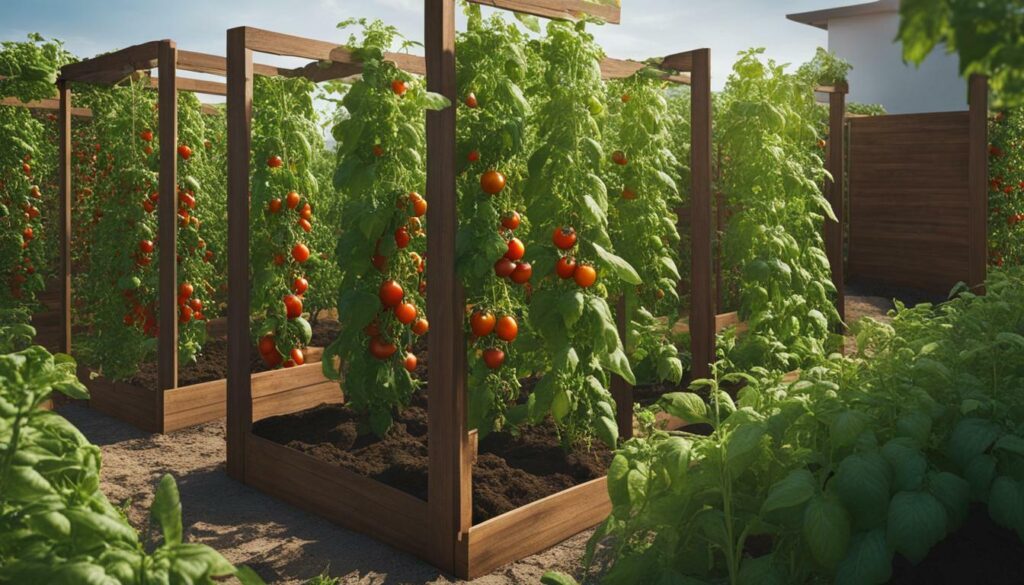
| Advantages of Vertical Tomato Gardens | Benefits |
|---|---|
| Prevention of soil-borne diseases and pest infestations | Keeps plants off the ground, reducing contact with soil and potential pathogens |
| Improved air circulation | Reduces moisture levels on leaves, preventing fungal diseases |
| Enhanced sunlight exposure | Promotes even ripening and higher fruit quality |
| Easier pest management | Pests are more visible and can be dealt with promptly |
“Vertical tomato gardens provide an efficient and effective way to prevent soil-borne diseases and pest infestations. They keep the plants elevated, reducing the risk of rot, mold, and pest damage.” – Gardening expert
In summary, vertical tomato gardens offer several advantages in terms of improved plant health and disease prevention. By keeping the plants off the ground, ensuring better air circulation, and maximizing sunlight exposure, vertical gardening systems create optimal conditions for healthy tomato plants and high-quality fruit. Additionally, the ease of pest management in vertical gardens makes it a preferred choice for many gardeners. With proper care and attention, vertical tomato gardens can provide a bountiful harvest of delicious tomatoes.
Enhanced Sunlight and Air Circulation
Vertical tomato gardens allow for the even distribution of sunlight and improved air circulation, which contributes to healthier growth and better fruit production. With traditional ground-based gardening, tomato plants can become tangled and sprawl along the ground, limiting their exposure to sunlight and hindering air circulation. In vertical gardens, however, the plants are trained to grow upward using support systems such as trellises, cages, or stakes.
The vertical orientation of the plants ensures that each leaf receives adequate sunlight, promoting photosynthesis and the production of energy for plant growth. This leads to stronger, more robust plants and can result in higher yields of juicy, flavorful tomatoes. Additionally, vertical gardening allows for ample air circulation around the foliage, which helps prevent the growth of mold, mildew, and other diseases that thrive in humid conditions.
By lifting the tomato plants off the ground, vertical gardens also reduce the risk of soil-borne pests and diseases. In traditional gardening methods, plants in contact with the soil are more susceptible to diseases and pests that thrive in a moist, warm environment. Vertical gardens keep the plants elevated and dry, making it more difficult for pests to reach the foliage and fruit. Additionally, the spread-out nature of vertical gardens makes it easier to spot and combat potential pest infestations.
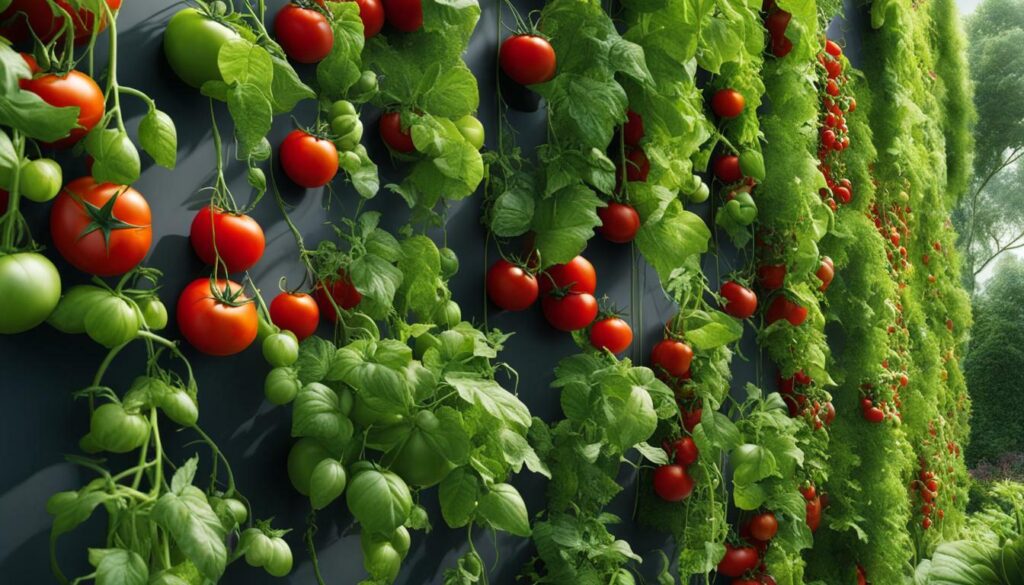
When it comes to air circulation, vertical gardens allow for better airflow between the tomato plants, minimizing the risk of stagnant air pockets that can lead to the development of fungal diseases. Adequate air circulation also helps in the transpiration process, allowing the plants to release excess moisture and prevent waterlogged roots. This is especially important in regions with high humidity or frequent rainfall.
In summary, vertical tomato gardens offer numerous advantages in terms of sunlight exposure and air circulation. By training the plants to grow vertically, gardeners can maximize their yield and create a healthier environment for their tomato plants, resulting in a bountiful harvest of delicious homegrown tomatoes.
Pest Management and Easy Harvesting
With the vines and foliage spread out in a vertical garden, pests are easier to spot and control, and harvesting tomatoes becomes a breeze. Vertical tomato gardens make it easier to detect potential pest infestations because the vines and foliage are spread out, allowing for better visibility. This means that you can quickly identify any pests that may be damaging your tomato plants and take immediate action to control them.
Additionally, the structure of a vertical garden makes it harder for pests to move from one plant to another, reducing the risk of infestations spreading. By keeping your tomato plants lifted off the ground, you minimize contact with soil-borne pests and diseases, such as slugs and soil-borne fungi. This can help prevent your plants from becoming susceptible to these common tomato garden problems.
Harvesting tomatoes from a vertical garden is also much more convenient. The fruits are more accessible and easier to reach when they are hanging vertically, making it easier to pluck them off the plants. You won’t have to bend over or search through dense foliage to find ripe tomatoes. This not only saves time but also reduces the risk of damaging the plants or knocking off unripe fruits during the harvest process.
Table: Common Tomato Pests and How to Control Them
| Pest | Control Measures |
|---|---|
| Aphids | Use insecticidal soap or neem oil spray. Introduce beneficial insects like ladybugs or lacewings to feed on aphids. |
| Tomato Hornworms | Handpick and remove the hornworms from the plants. Apply Bacillus thuringiensis (BT) as a biological control. |
| Whiteflies | Use yellow sticky traps to monitor and catch adult whiteflies. Apply insecticidal soap or neem oil spray to control nymphs and adults. |
| Spider Mites | Regularly spray plants with water to discourage spider mites. Use insecticidal soap or neem oil spray to control severe infestations. |
Remember to regularly inspect your plants for any signs of pest activity and take action immediately. By implementing proper pest management techniques in your vertical tomato garden, you can ensure the health and productivity of your plants and enjoy a bountiful harvest of delicious homegrown tomatoes.
Choosing the Right Location
When choosing a location for your vertical tomato garden, it is important to consider several factors that can contribute to the success of your plants. Sunlight exposure, temperature, and access to water are all essential considerations in finding the ideal spot for your garden.
Sunlight exposure is crucial for tomato plants as they require a minimum of six hours of direct sunlight daily for optimal growth and fruit production. Choose a location that receives ample sunlight throughout the day, preferably one with at least eight hours of full sunlight. If you have limited access to sunlight, consider using grow lamps to supplement the natural light for your tomatoes.
The temperature is another vital factor to consider when selecting the right location for your vertical tomato garden. Tomato plants thrive in warm environments, so choose a spot that is sheltered from strong winds and provides a favorable microclimate. It is important to note that tomatoes are susceptible to frost damage, so make sure to avoid planting them in areas prone to late-season frosts.
Access to water is essential for any successful garden, and tomatoes are no exception. Choose a location that is easily accessible for regular watering, as tomatoes require consistent moisture to thrive. However, it is equally important to ensure good drainage to prevent waterlogging and root rot. If you are planting in-ground, consider a location with well-draining soil. For container gardens, choose pots with drainage holes to ensure excess water can escape.
By considering these factors when choosing the right location for your vertical tomato garden, you can create an environment that promotes healthy plant growth and abundant harvests. Take the time to assess your available space and find the best spot to maximize sunlight exposure, maintain optimal temperatures, and provide easy access to water for your tomato plants.
| Factors | Considerations |
|---|---|
| Sunlight Exposure | At least 6 hours of direct sunlight daily |
| Temperature | Warm, sheltered from strong winds |
| Access to Water | Easily accessible for regular watering, good drainage |
Remember, the success of your vertical tomato garden depends heavily on the location you choose. By considering the amount of sunlight, temperature conditions, and access to water, you can create an optimal environment for your tomato plants to thrive and produce bountiful harvests.
Selecting the Best Tomato Plants
When choosing tomato plants for your vertical garden, opt for indeterminate varieties that will grow upwards and thrive in a vertical support system. Indeterminate tomatoes are known for their continuous growth, reaching heights of up to 12 feet, and producing fruit throughout the growing season. These types of tomatoes require staking or caging to support their vigorous growth.
Some popular indeterminate tomato varieties suitable for vertical gardens include ‘Big Beef’, ‘Black Krim’, ‘Cherokee Purple’, ‘Jaune Flammée’, ‘Stupice’, ‘Juliet’, ‘Sun Gold’, and ‘Yellow Pear’. These varieties have been proven to perform well in vertical gardening systems, offering a range of flavors, colors, and sizes to suit different preferences. Whether you prefer juicy large beefsteak tomatoes or sweet cherry tomatoes, there is a variety to suit every taste.
It’s important to consider the specific growing conditions of your vertical garden when selecting tomato plants. Factors such as sunlight exposure, soil quality, and available space should be taken into account. Indeterminate tomatoes require a minimum of six hours of direct sunlight per day to thrive and produce abundant fruit. They also prefer well-draining soil that is rich in organic matter.
Before planting, prepare the soil by incorporating organic matter and fertilizer to ensure optimal nutrient availability for the tomato plants. This will promote healthy growth and improve fruit production. Additionally, consider planting multiple varieties to diversify your harvest and reduce the risk of total crop loss in case of disease or pest infestation.
| Variety | Type | Size | Days to Harvest |
|---|---|---|---|
| Celebrity | Indeterminate | Standard | 70 |
| Big Beef | Indeterminate | Standard | 73 |
| Black Krim | Indeterminate | Standard | 75 |
| Cherokee Purple | Indeterminate | Standard | 72 |
| Stupice | Indeterminate | Standard | 60-65 |
| Juliet | Indeterminate | Cherry | 62 |
| Sun Gold | Indeterminate | Cherry | 65 |
| Yellow Pear | Indeterminate | Cherry | 78 |
Quick Tips for Selecting Tomato Plants:
- Choose indeterminate varieties for vertical gardens to maximize space and yield.
- Consider sunlight exposure, soil quality, and available space when selecting tomato plants.
- Opt for locally proven varieties with disease resistance (VFN) for better success.
- Plant multiple varieties to diversify your harvest and reduce the risk of crop loss.
- Prepare the soil with organic matter and fertilizer before planting.
By selecting the right tomato plants for your vertical garden and providing them with proper care and support, you can enjoy a bountiful harvest of delicious homegrown tomatoes throughout the growing season.
Container Gardening Tips
If you plan on growing a vertical tomato garden in containers, consider the size of the pot, proper drainage, and the use of quality soil and fertilizer. Container gardening is a great option for small space gardening, allowing you to grow tomatoes even if you don’t have access to a large backyard or garden area. Here are some tips to ensure success with container gardening for your vertical tomato garden:
1. Choose the right container size:
The size of the pot is important when growing tomatoes in containers. Larger pots provide more room for the roots to grow and can hold more soil, which helps with moisture retention. For indeterminate tomato plants, choose pots that are at least 20 inches in diameter to accommodate their taller growth. Determinate tomatoes can be grown in smaller pots, around 14-16 inches in diameter.
2. Ensure proper drainage:
Good drainage is essential for container gardening. Make sure your pots have drainage holes at the bottom to prevent water from accumulating and causing root rot. You can place a layer of small rocks or broken pottery pieces at the bottom of the pot to facilitate drainage.
3. Use quality soil and fertilizer:
Choose a high-quality potting mix specifically formulated for container gardening. Avoid using garden soil, as it can become compacted and drain poorly in containers. Look for a mix that is well-draining and enriched with organic matter. Additionally, fertilize your tomato plants regularly with a balanced fertilizer to provide the nutrients they need for healthy growth and fruit production.
4. Provide support for your plants:
Even in containers, vertical tomato plants will benefit from a support system to keep them upright and prevent them from sprawling. You can use stakes, trellises, or tomato cages to support the plants as they grow. Install the support system when you first plant the tomatoes to avoid damaging the roots later on.
Overall, container gardening offers a convenient and space-efficient way to grow tomatoes vertically. By following these tips, you can create a thriving vertical tomato garden in your backyard, patio, or balcony.
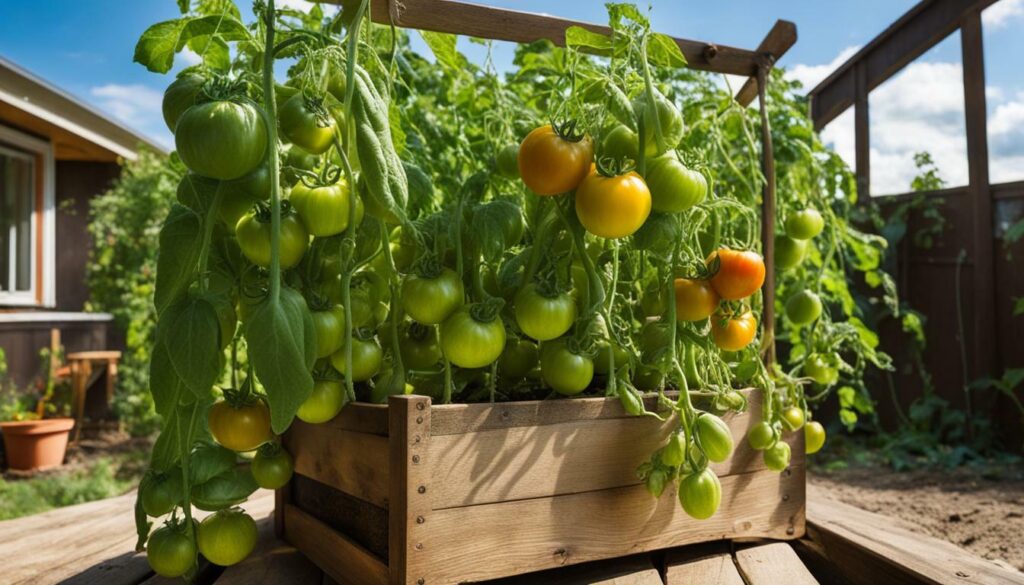
| Benefits of Container Gardening for Vertical Tomatoes |
|---|
| 1. Allows for gardening in small spaces. |
| 2. Provides better control over soil conditions. |
| 3. Easy to move and rearrange plants as needed. |
| 4. Reduces the risk of soil-borne diseases. |
| 5. Can be used indoors or outdoors. |
| 6. Ideal for renters or those with limited gardening space. |
Container gardening offers a versatile and accessible way to grow tomatoes vertically, even in small spaces. With the right container size, proper drainage, quality soil, and a support system, you can enjoy a bountiful harvest of delicious tomatoes right in your own backyard or balcony. Happy gardening!
Conclusion
By mastering the basics of vertical tomato gardening, you can create a thriving garden in your backyard, even with limited space, and enjoy the bountiful harvest of homegrown tomatoes. Vertical tomato gardens offer numerous benefits, including space efficiency, increased yield, improved plant health, disease prevention, enhanced sunlight and air circulation, pest management, and easy harvesting. These gardens make it possible for anyone, regardless of their backyard size, to grow their own tomatoes.
Vertical tomato gardens utilize physical support systems like trellises, cages, or stakes to train tomato plants to grow vertically. This method maximizes space, allowing for more plants in a smaller area, resulting in higher yields. The plants are lifted off the ground, reducing the risk of pests and diseases, and facilitating better air circulation for healthier plants.
Furthermore, vertical tomato gardens improve sunlight exposure, ensuring even distribution throughout the foliage and on the fruits. This promotes better ripening and enhances the flavor of the tomatoes. Additionally, these gardens make pest management easier by making potential pests more visible, and harvesting becomes more convenient as the vines are spread out and easily accessible.
When starting a vertical tomato garden, it is important to choose the right location that receives at least eight hours of full sunlight and has good drainage. Selecting the appropriate tomato plants is crucial, with indeterminate varieties being the preferred choice for vertical gardens. Container gardening is also a viable option for vertical tomato gardens, with larger pots recommended for indeterminate tomato plants.
Remember to provide proper care to your vertical tomato garden, including regular watering, feeding with a balanced fertilizer, and inspecting for signs of insect or disease damage. With these tips and techniques, you can successfully grow your own delicious, homegrown tomatoes in your backyard vertical garden.
How Can I Adapt the Steps for Building a Vertical Garden on a Balcony to a Backyard Setting?
Adapting the vertical garden balcony tutorial to a backyard setting involves considering the available space and sunlight. You may need to adjust the layout and structure to fit the larger area. Additionally, you’ll have more flexibility in plant selection and can incorporate taller plants or trellises for added height.
FAQ
Q: What is a vertical tomato garden?
A: A vertical tomato garden is a gardening technique where tomato plants are trained to grow vertically with the help of physical support systems like trellises, cages, stakes, or other structures.
Q: Why should I grow a vertical tomato garden?
A: Vertical tomato gardens are a great option for those with limited space or those who want to maximize their yield per square foot. They also keep tomatoes dry, clean, and lifted off the soil, facilitate better air circulation and sunlight distribution, make pests easier to spot and exterminate, and make it easier to harvest tomatoes.
Q: How do I grow a vertical tomato garden?
A: Start by choosing a warm location with at least 8 hours of full sunlight. Select indeterminate tomato plants, as they are better suited for vertical growing. If using containers, choose larger pots with good drainage. Plant the tomatoes in the ground or pots, guide the plants to the support structure, and use quality nutrient-rich soil. Water regularly, feed with fertilizer, and inspect for pests and diseases.
Q: What are the benefits of vertical tomato gardening?
A: Vertical tomato gardening allows for more efficient use of space, promotes better air circulation and sunlight exposure, reduces the risk of pests and diseases, and makes harvesting easier. It also creates a visually appealing garden.
Q: Can I grow a vertical tomato garden indoors?
A: Yes, vertical tomato gardens can be maintained indoors or outdoors, in pots or in-ground. If growing indoors, consider using grow lamps to maintain the proper temperature and provide sufficient light.
Q: How do I choose the right location for a vertical tomato garden?
A: Choose a location that is warm, exposed to at least 8 hours of full sunlight, and easily accessible for watering. Consider planting in-ground tomato plants near a fence or wall for support.
Q: What types of tomato plants are best for vertical gardens?
A: Indeterminate tomato plants are best suited for vertical gardens as they grow continuously and require a physical support system to keep them off the ground. Varieties like ‘Big Beef’, ‘Black Krim’, ‘Cherokee Purple’, ‘Juliet’, and ‘Sun Gold’ perform well in vertical gardens.
Q: Can I grow tomatoes in containers for a vertical garden?
A: Yes, tomatoes can be successfully grown in containers for a vertical garden. Choose larger pots with good drainage and select determinate or indeterminate tomato plants according to the size of the container.
Q: How can I protect my vertical tomato garden from pests and diseases?
A: Regularly inspect your plants for signs of insect and disease damage. Early control is important to prevent the spread of pests and diseases. Using organic pest control methods and providing proper air circulation can help reduce the risk of infestations.
Q: What are the different growth habits of tomato plants?
A: There are two main growth habits of tomato plants: determinate and indeterminate. Determinate tomatoes are bush-type plants that grow to a compact height and produce fruit all at once. Indeterminate tomatoes are vining plants that continue to grow and produce fruit until killed by frost or external factors.
Q: What are some recommended tomato varieties for vertical gardening?
A: Some recommended tomato varieties for vertical gardening include ‘Celebrity’, ‘Tycoon’, ‘Big Beef’, ‘Black Krim’, ‘Cherokee Purple’, ‘Early Girl’, ‘Juliet’, ‘Sun Gold’, ‘Sweet 100’, ‘Yellow Pear’, ‘Roma’, and ‘Viva Italia’.

